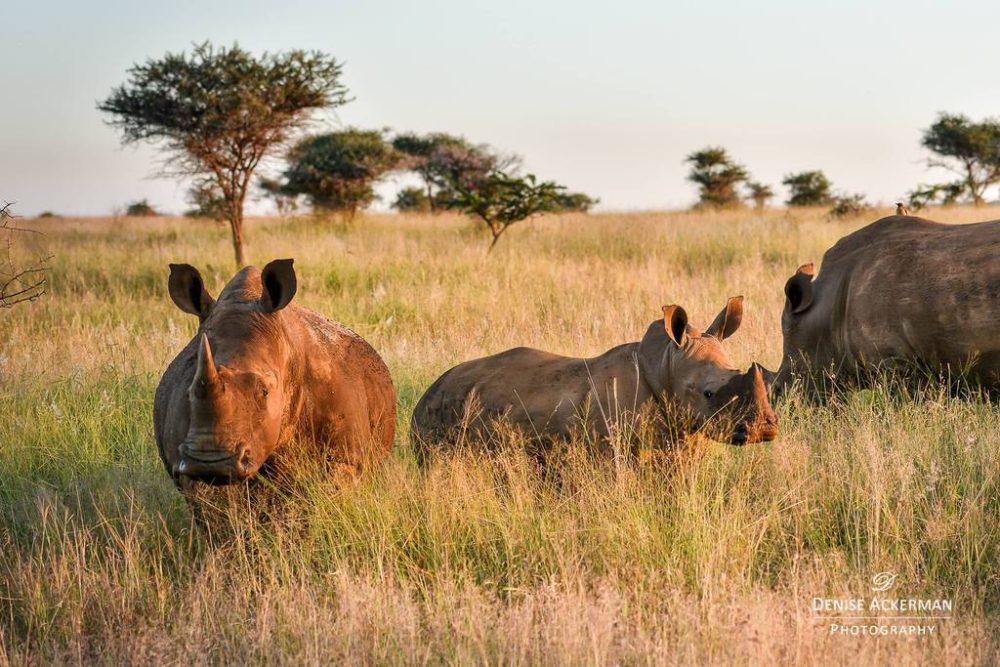

Intervention from the government, to imprison hunters and increase legal hunting, is considered in this model to counter overpoaching. This paper discusses how the illegal poaching could affect the dynamics of the southern white rhino. Hence, unlike previously mentioned references, the aim of this article is to give an alternative perspective of the poaching problem of the southern white rhino, which, in this case, is from a mathematical point of view, especially with a dynamical system approach. According to the above explanation and to the best of our knowledge, there are few mathematical models concerning the dynamics of southern white rhinos, especially since it was affected by illegal and legal poaching. The authors of propose a mathematical model to describe a strategy to harvest rhinos such that the population can still survive. Their result suggests that dehorning should be done annually under some circumstances. The authors of discuss the idea of optimal frequency to dehorning the rhinos. For example, optimal control is used in to minimize infected prey by harvesting or treating the infected population as the control variables. It can also be used in a predator–prey model with infections among prey or predator populations, known as an eco-epidemiology model. Optimal control theory is usually applied to control the spread of a disease in an epidemiology model, as proposed in. Several previous studies have been constructed a more complex predator–prey mathematical model based on the Lotka–Volterra model in.

Lotka in 1925 and Vito Volterra in 1926 proposed a simple model, known as the Lotka–Volterra model, to understand the interaction involving two species, namely one predator and one prey. The issue of rhino poaching, as described, can be compared to predator–prey interactions with white rhinos as prey and humans (hunters) as predators.

Īccording to, one way to learn about real-world problems is by constructing a mathematical model. Because of overpoaching, there has not been any significant increase in the southern white rhino population since 2011 in Kruger National Park, South Africa. Climate and environmental changes can also influence the dynamics of rhino population. An overpoaching of white rhinos could lead to an environmental change. It involves microchipping rhino horns so the government can track the horn and arrest the hunters. One of the initiatives is to overcome poaching. Other efforts can also be applied to preserve white rhinos. A study about the impact of human intervention on different translocation strategies is discussed in. In order to increase the population of the rhino, a translocation strategy has been implemented. During 2007–2014, the country has experienced an increase in rhino poaching of over 9300%. Previously in 2007, only 13 rhinos were killed due to poaching, but that number has increased exponentially. Poaching becomes a severe problem that threatens the preservation of southern white rhinos. Ī high demand for rhino horns has led to a poaching crisis in South Africa. Cottoni) is extinct in the wild due to poaching, and only two females remain in captivity. Simum) remain viable with a total of about 19,600–21,000 individuals inhabiting South Africa, Namibia, Zimbabwe, and Kenya. However, only populations of the southern white rhino ( C. Two genetically different subspecies exist. The white rhino ( Ceratotherium simum) is one of the five living species of rhinoceros. The results show that the hunter population can be more easily controlled with a time-dependent hunter arrest rate rather than by treating it as a constant. Analysis of the cost function effectiveness is conducted using the ACER (Average Cost–Effectiveness Ratio) and ICER (Incremental Cost–Effectiveness Ratio) indicator method. Optimal control simulations are given to provide additional insight into the dynamics of the model. The optimal control is then constructed using Pontryagin’s minimum principle and solved numerically with an iterative forward–backward method. Therefore, an optimal strategy is needed. From an analytical result, it is trivial that arresting as many hunters as possible helps conserve white rhinos, but it comes at a high cost. We investigate the existence and the stability of the equilibrium points, which depend on some threshold functions. We divide the southern white rhino population into three classes based on their horn condition. The model constructed is based on a predator–prey model with southern white rhinos as prey and humans (hunters) as predators. In this paper, a novel dynamical population model of a southern white rhino with legal and illegal poaching activity is introduced.


 0 kommentar(er)
0 kommentar(er)
